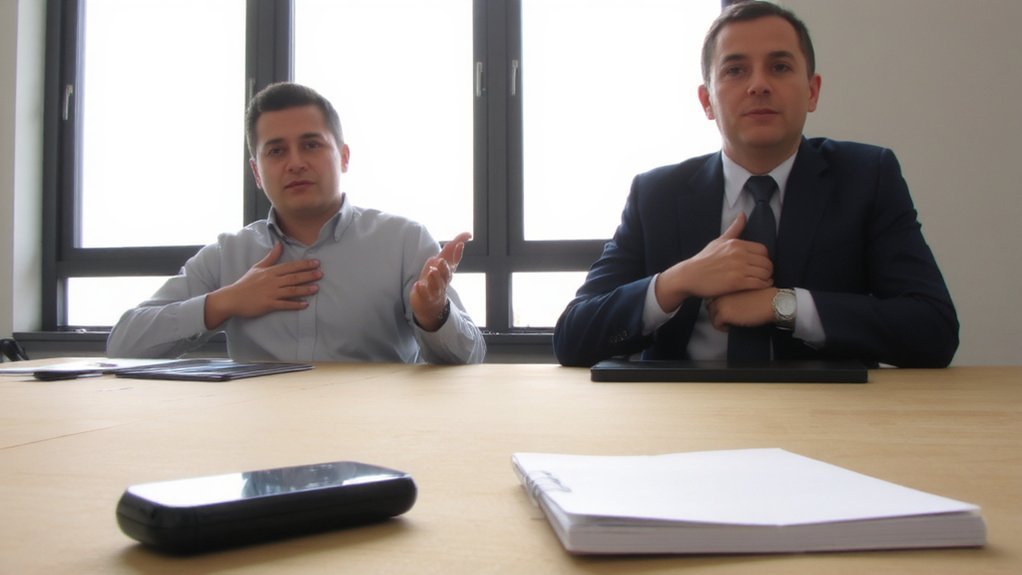You’ll handle conflict best when you pause, listen objectively, and ask clear questions instead of assuming motives. Use calm “I” statements, restate observable facts, and offer practical options with timelines. These steps reduce heat and create accountability—keep going to see a simple, repeatable process that helps you resolve issues and move forward…
Common Causes of Workplace Conflict

Why are people at odds with each other on the job? You often face conflicts because roles and expectations aren’t clear, so people step on each other’s tasks.
Miscommunication and assumptions escalate small issues; you see conversations that lack directness or follow-up. Competing goals and limited resources make teams prioritize differently, and you’ll clash over deadlines or budget.
Personality differences and work styles create friction when you prefer directness and others avoid confrontation. Poor leadership or inconsistent policies let resentment grow, and unequal workload or perceived favoritism undermines trust.
Organizational change and unclear priorities add stress, pushing people to protect their turf. Recognizing these root causes helps you target solutions rather than just treating symptoms. You’ll then be better equipped to resolve conflicts constructively.
How to Recognize Early Signs and Impact

After you’ve identified common causes, watch for early signals that a conflict is forming so you can address it before it escalates.
Notice subtle shifts: curt emails, missed deadlines, repeated interruptions, or people avoiding each other.
Pay attention to tone and frequency of complaints, rising tension in meetings, or a drop in collaborative contributions. Track patterns over days rather than isolated incidents.
Consider the impact: lowered morale, reduced productivity, higher error rates, and increased turnover risk. Document observable facts and timelines so you can explain the situation objectively.
Involving a neutral observer or manager early can clarify whether issues are interpersonal, workload-related, or systemic. You’ll make better decisions when you act on real patterns quickly.
Communication Skills to De-escalate Tension

When tensions rise, use clear, calm communication to defuse them: listen without interrupting, acknowledge feelings, and ask open questions to understand the other person’s perspective.
Stay steady in tone, slow your speech, and keep your posture relaxed so you don’t escalate defensiveness.
Use “I” statements to express impact without blaming, and paraphrase what you hear to confirm understanding.
Name emotions succinctly — “I hear frustration” — to validate experience.
Pause before replying to avoid reactive comments, and use brief, specific requests rather than vague demands.
If you need a break, suggest a short pause and a time to resume.
Maintain respect, avoid sarcasm, and focus on shared goals to rebuild collaboration.
Practice these skills regularly so you’ll respond calmly and keep conflicts from escalating in future.
Step-by-Step Conflict Resolution Process

Follow a clear, step-by-step process so you can resolve conflicts efficiently and preserve working relationships.
First, define the specific issue and its impact; avoid labels and stick to observable facts.
Next, meet with the other person and listen; don’t interrupt, and ask clarifying questions.
Then, restate the problem to confirm understanding and agree shared goals for a solution.
Brainstorm options together, evaluating pros and cons and prioritizing win-win outcomes.
Choose a concrete action plan with responsibilities, deadlines, and measurable results.
Document the agreement and circulate it.
Implement the plan, monitor progress, and check in regularly.
If adjustments are needed, revisit steps collaboratively and promptly to keep momentum and prevent escalation.
Keep emotions in check, stay solution-focused, and celebrate small successes to rebuild trust together quickly.
Leadership and HR Roles in Managing Disputes

Although frontline leaders handle most day-to-day tensions, you should expect HR to provide policy guidance, neutral facilitation, and escalation support.
You’ll act first: address behavior, document incidents, and mediate between employees when issues are limited and reversible.
Don’t ignore patterns; escalate complex, recurring, or legally sensitive matters to HR promptly.
HR will assess complaints objectively, lead formal investigations, advise on legal and policy implications, and recommend corrective action.
Together you’ll coordinate timelines, preserve confidentiality, and maintain clear records for fairness.
When disciplinary decisions arise, follow HR’s recommended process to ensure consistency.
After resolution, monitor compliance and close the case. Document outcomes and communicate timelines.
Rely on this division of labor: you manage the immediate people work, and HR manages formal, procedural, and legal dimensions.
Preventing Conflict by Building a Resilient Culture
If you want fewer workplace disputes, build a resilient culture that catches problems early and makes respectful behavior the norm.
You’ll encourage open communication, teach conflict skills, and set clear expectations so small issues don’t escalate.
Model transparency and accountability: leaders admit mistakes, give feedback constructively, and enforce standards consistently.
Offer regular training on active listening, giving and receiving feedback, and managing stress.
Create safe channels for raising concerns—anonymous, one-on-one check-ins, and mediation—so people speak up without fear.
Recognize and reward collaboration and empathy to reinforce positive norms.
Track incidents and responses to spot patterns and adjust policies.
When you embed these practices, your team becomes adaptable, trust grows, and conflicts shrink before they start.
You’ll save time, reduce turnover, and improve performance measurably.
Conclusion
You’ll handle workplace conflict better when you stay calm, listen objectively, ask clarifying questions, and describe issues with observable facts instead of labels. Use calm “I” statements to explain impacts, propose practical options, and agree on responsibilities and deadlines. Take breaks or involve a neutral leader or HR for sensitive or persistent disputes, document agreements, and follow up. By learning from each situation and building transparent communication, you’ll prevent many conflicts and strengthen team resilience.